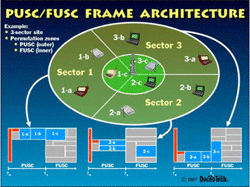|
WiMAX and 802.16e: Broadband Wireless Standards TM |
|
 |

A technical class
covering the 802.16 standard, and the WiMAX implementations that
are most relevant to your next design project |
|
Course
Description:
IEEE 802.16-2004 and 802.16e are standards for broadband wireless
access technology. The 802.16-based implementations named WiMAX
(Worldwide Interoperability for Microwave Access) are used for
applications that include mobile broadband, "last mile" fixed
broadband connections, hotspot and cellular backhaul, and
high-speed enterprise connectivity for businesses.
This course will provide the student with detailed knowledge on
the contents of WiMAX and 802.16 standards, as well as WiMAX
technologies, trends, and issues. We have included content that is
emerging from recent IEEE 802.16 working group meetings and letter
ballots. These are the critical topics for todays development
projects.
Course length:
2 days
Pre-Requisite:
A technical background in wireless communications
Audience:
This course is designed for students who are working on WiMAX and
802.16 products and services, or expect to be working on those
projects soon. A student who is just beginning to work on
broadband wireless projects will gain a full understanding of the
entire set of 802.16 standards. Students who are working in WiMAX
will deepen their understanding of standards issues, operations
and
management concerns. |
|
This DoceoTech course was co-authored by Subbu Ponnuswamy, 802.16
standards contributor and coauthor of WirelessMAN: Inside the IEEE
802.16 Standard for Wireless Metropolitan Networks by IEEE Press.
Dr. Todor Cooklev, also a co-author of this DoceoTech course. was
chosen by the IEEE to write their definitive book that covers all
wireless standards, which is named Wireless Communication
Standards: A Study of IEEE 802.11, 802.15, 802.16.
|
|
Course Outline: |
-
Overview of Broadband Wireless Markets,
Applications, and Requirements
-
Architecture of a broadband wireless access network
-
Line of Sight vs Non-Line-of-Sight
-
Mobility
-
Advanced Antenna Systems
-
Quality of Service
-
The role of the WiMAX Forum
-
802.16 High-level Architecture
-
Physical Architecture
-
Protocol Architecture
-
Time Slots and Time Division Multiple Access
-
Uplink and Downlink Channel
Descriptors and Maps
-
Time Division Duplex and Frequency Division Duplex
Options
-
Which Implementation Options are most common?
-
802.16 Medium Access Control
-
Steps for Joining an 802.16 network
-
Addressing and Encapsulation
-
Bandwidth Requests and Allocation
-
Automatic repeat request (ARQ)
-
Security
-
Quality of Service Scheduling Rules
-
MAC enhancements for advanced antenna systems
- 802.16 Physical Layer
-
Why are there so many PHY options?
-
Multipath: Why multi-carrier approaches?
-
Orthogonal Frequency Division Multiplexing (OFDM)
-
Multi-carrier OFDM for 2-to-11 GHz Licensed
Operation
-
Multi-carrier OFDM for 2-to-11 GHz Unlicensed
Operation
-
Digital Signal Processing algorithms beyond the
standard
-
Orthogonal Frequency Division Multiplexing Access (OFDMA)
for licensed and unlicensed use
-
Mobility extensions from 802.16e
-
802.16e adoption forecast
-
802.16e MAC and PHY enhancements
-
Scalable OFDMA
-
Handover
-
Cell Selection
-
Options for 802.16 Implementers
-
Advanced antenna systems
-
Coexistence problems and specifications
-
WiMAX Profiles
-
WiMAX Forum Certification
WiMAX, WiMAX Forum, and WiMAX Forum
Certified are trademarks of the WiMAX Forum. IEEE
802.16 is a trademark of the IEEE.
|
|